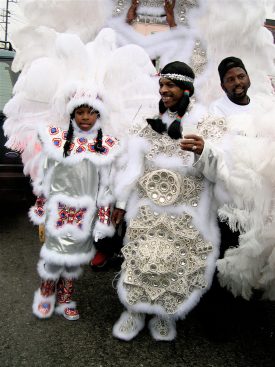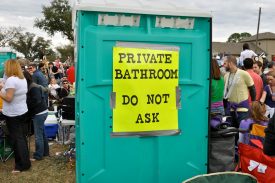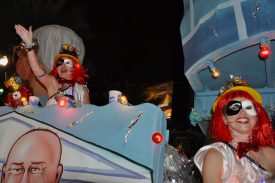More a cultural phenomenon/art form than an “event,” Mardi Gras is a diffuse, citywide affair that can be experienced on many different levels. To help visitors successfully navigate the panorama of its bounty and avoid missteps, Mardi Gras Tips & Ticks offers a compendium of seasoned advice on parade etiquette, reaping throw booty, balcony and grandstand access, how to catch a ride in a float parade and more..
Advice and Insights on the New Orleans Mardi Gras Celebration
Big Chief Charles Taylor and members of the White Cloud Hunters Mardi Gras Indians outside the Backstreet Cultural Museum on Mardi Gras 2003
There’s a kaleidoscope of intriguing cultural phenomena to behold beyond the confines of the tourist district.
When contemplating a trip to Mardi Gras, it helps to understand from the get-go that the gala is diffuse and generally lacking in centralized organization. More a cultural phenomenon/art form than an “event,” it encompasses a dizzying amalgamation of habits and happenings that can be experienced on many different levels. Revels range from intimate gatherings with king cake and Champagne to glittering, elaborately choreographed balls; from thematic parades with marching bands and fantastic floats to spontaneous eruptions of dance and joie de vivre in the street; from costume contests to coronation ceremonies; from family-oriented parade-viewing picnics with red beans and rice to debutante tea parties; from krewe-sponsored “extravaganzas” to free concerts in public spaces; from the frenzied spectacle of Bourbon Street to offbeat expressions of indigenous grassroots culture on neighborhood back streets.
While the French Quarter is ground zero for the Mardi Gras tourist, the celebration is a citywide affair and as such, visitors who confine themselves to the Quarter won’t get the full panorama. The tourist district is not where you’ll find magnificently beaded and plumed Mardi Gras Indians strutting their stuff and laying down hypnotic chants and percussive beats. The Garden District, Uptown and Mid-City (for Endymion) offer some of the choicest settings for parade viewing. And many of the best music venues are found outside the Quarter. (For band listings and venues, as well as rich coverage of the music scene, visit OffBeat.com or WWOZ.org or download their apps).
If you’re drinking and reveling in the racy side of the festivities, keep your wits about you and indulge at your own risk. Many people assume that because it’s a celebration known for mass inebriation, imbibing to excess at Mardi Gras is perfectly acceptable, if not expected. But just because New Orleans likes to trade on its famously relaxed, laissez-faire reputation — Sin City on the Bayou — doesn’t mean the coast is all clear when sailing three sheets to the wind, with a prayer to the god who looks out for fools.
Public drunkenness — often in combination with resisting arrest, disturbing the peace or lewd behavior — is a leading cause of arrest during the festivities. If you pass out on a door stoop or a bench, or get caught urinating in public, there’s a good chance you’ll wind up in a place where there is no happy hour — Central Lock-up.
That said, New Orleans cops generally take a “live and let live” approach to intoxicated partiers caught up in the thrall of Mardi Gras Madness, so long as they maintain some semblance of common sense. Just don’t think it’s okay to act with wanton abandon because it’s New Orleans and “anything goes.”
Porta potty on parade route neutral ground
Even neophyte parade goers quickly learn to become mindful of lavatory logistics.
And don’t think just because the city permits the consumption of alcohol in the streets that police are somehow lax about drinking and driving — far from it. If anything, they’re particularly vigilant during Mardi Gras, because they know people are partying. So if you’re driving around the city at night or heading to or from the suburbs, don’t be surprised to encounter an alcohol checkpoint.
If you do drive, note that parking ordinances are strictly enforced during the festivities — a veritable bonanza for tow companies and the city’s parking violations bureau. Especially during the last five last days of Carnival ending Fat Tuesday, finding street parking in close proximity to the French Quarter or an active parade route is notoriously difficult. Thus, knowing your options regarding parking lots, taxis/ride-sharing and public transportation can save time, trouble and money.
In New Orleans during Mardi Gras, where the gaudiest things in life are free, revelers are consumed by a collective mania to acquire beads and baubles — a feeding frenzy that might seem dangerously maniacal if it wasn’t so darn entertaining. If you want to claim a worthy share of the coveted spoils, consider boning up on proven stratagems and techniques. As for the infamous Mardi Gras barter economy on Bourbon Street, like it or not, the flesh-baring revels have become a bona fide tourist attraction. If you do decide to partake in Mardi Gras immodesty, beware of police, leering paparazzi and the fact that, thanks to the Internet and social media, what is revealed in New Orleans doesn’t necessarily stay in New Orleans.
As the celebration’s main event, parades, especially during the last five days of Carnival, draw big crowds and present logistical issues — not the least of which is finding a place to pee. Other considerations: what to bring to parades, where to view them, safety issues and etiquette. For the skinny on all this and more, click here.
A pair of comfortable shoes is a good idea if you plan on attending parades, as you’ll probably be walking quite a bit. Also note that weather in New Orleans during Mardi Gras can vary considerably, so be sure to pack appropriate clothing.
If you plan on bringing the kids, precautions are in order. Don’t allow them to chase after parade floats for throws. Also, because float riders can sometimes be errant or overly aggressive in their throwing, be on the alert and ready to deflect heavy beads and other items hurled in the direction of children. Stepladders are a popular way to provide children with a good view of parades and make it easier for them to snag throws. However, ladder-related accidents happen every Mardi Gras, so be sure to follow safety rules.
Krewe of Muses parade
Playing Santa Claus in a Mardi Gras parade, bestowing beads and baubles, can be quite a thrill.
Parties and balls come in many guises during the season of merriment that begins on feast of the Epiphany (Jan. 6) — the twelfth day of Christmas, the day the gift-bearing wise men visited the Christ child — and culminates on Mardi Gras (Fat Tuesday). While visitors won’t likely have the opportunity to attend a high-society Carnival ball, which tend to be exclusive, invitation-only affairs, some krewe fêtes are accessible to non-members.
Ever wonder what it’s like to ride on a float in a Mardi Gras parade? Well, what’s not to like about reveling in the thrill of playing Santa Claus and bestowing flashy treasures into the outstretched hands of a jazzed crowd? There is a compelling, almost surreal theatricality intrinsic to the whole experience, and some parading krewes let outsiders join in the fun — for a price.
The availability of hotel rooms depends in part on the date of Mardi Gras, which can occur on any Tuesday from February 3 through March 9, and your actual arrival date. For the lowdown on minimum-stay requirements and how hotels manage their room inventory for Mardi Gras, click here.
Now, as they like to say down Louisiana way, Laissez les bon temps rouler (Let the good times roll) — and Happy Mardi Gras!
MardiGrasTraditions.com



